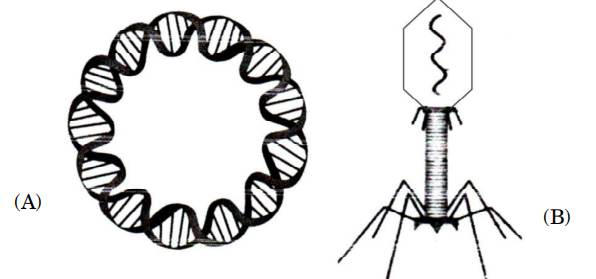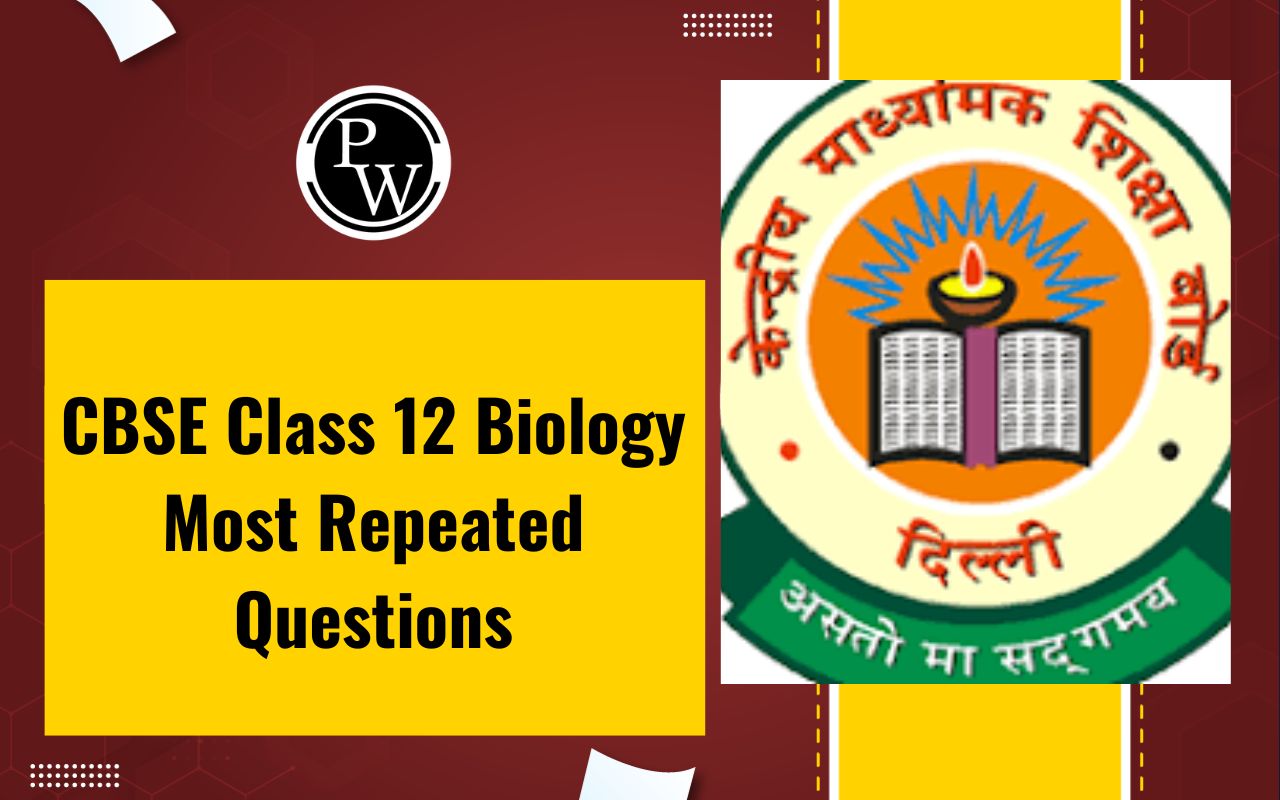The CBSE Class 12 Biology Exam 2024 will follow a structured pattern to assess students understanding across various topics:
Section A
: Contains 16 questions, each carrying
1 mark
. These are typically objective or very short answer-type questions.
Section B
: Comprises 5 questions, each worth
2 marks
. These require concise but explanatory answers.
Section C
: Includes 7 questions of
3 marks
each, demanding detailed explanations or illustrations.
Section D
: Features 2 case-based questions, each carrying
4 marks
. These test analytical skills and application of knowledge.
Section E
: Has 3 long-answer questions, each worth
5 marks
. These require in-depth understanding and elaboration, often integrating multiple concepts.
CBSE Class 12 Biology Most Repeated Questions with Answers
Here are some of the most repeated questions in CBSE Class 12 Biology, along with their detailed answers:
CBSE Class 12 Biology Most Repeated 1 Mark Questions
Q.1. Which one of the following processes results in the production of recombinants in future generations?
(i) Mutation
(ii) Independent assortment during meiosis I
(iii) Independent assortment during meiosis II
(iv) Crossing over of bivalents
Options:
(a) (iv) only
(b) (ii) and (iv)
(c) (i), (ii), and (iii)
(d) (i), (ii), (iii), and (iv)
Answer:
(b) (ii) and (iv)
Recombinants are formed due to
independent assortment during meiosis I
and
crossing over of bivalents
, which increase genetic variation.
Q.2. Study the DNA profiles obtained as a result of DNA fingerprinting of a child 'X' and three individuals 1, 2, and 3. Which one of the following options shows the possible parents of the child 'X'?

Options:
(a) 1 and 2
(b) 2 and 3
(c) 1 and 3
(d) Only individual 3
Answer:
(a) 1 and 2
The DNA profiles match the child’s bands with those of individuals 1 and 2, identifying them as the biological parents.
Q.3. The organism used in the construction of the first artificial recombinant DNA by Cohen and Boyer in 1972 was:
(a)
E. coli
(b)
Salmonella typhimurium
(c)
Agrobacterium tumefaciens
(d)
Bacillus thuringiensis
Answer:
(b) Salmonella typhimurium
Cohen and Boyer used
Salmonella typhimurium
to construct the first artificial recombinant DNA.
Q.4. Assertion (A):
A patient of ADA deficiency undergoing treatment for gene therapy requires periodic infusion of genetically engineered lymphocytes.
Reason (R):
Lymphocytes are immortal.
Options:
(a) Both A and R are true, and R is the correct explanation of A.
(b) Both A and R are true, but R is not the correct explanation of A.
(c) A is true, but R is false.
(d) A is false, but R is true.
Answer:
(c) A is true, but R is false.
Lymphocytes are not immortal, hence periodic infusions are required in gene therapy.
Q.5. Assertion (A):
A cattle egret and grazing cattle in close association is a classic example of commensalism.
Reason (R):
As grazing cattle move through the field, they stir up and flush out insects from the vegetation that otherwise might be difficult for egrets to find and catch.
Options:
(a) Both A and R are true, and R is the correct explanation of A.
(b) Both A and R are true, but R is not the correct explanation of A.
(c) A is true, but R is false.
(d) A is false, but R is true.
Answer:
(a) Both A and R are true, and R is the correct explanation of A.
This interaction benefits the egret without affecting the cattle.
Q.6. Mention two functions of codon AUG.
Answer:
(i) Acts as a start codon, initiating protein synthesis.
(ii) Codes for the amino acid methionine in protein synthesis.
Q.7. What is the economic value of Spirulina?
Answer:
Spirulina is a protein-rich supplement widely used to combat malnutrition and as a health food.
Q.8. Name the organism commercially used for the production of single-cell protein.
Answer:
Spirulina
or
Methylophilus methylotrophus
.
Q.9. Write the full form of ELISA.
Answer:
Enzyme-Linked Immunosorbent Assay.
CBSE Class 12 Biology Most Repeated 2 Marks Questions
Q.1. (i) Identify and name the structures 'A' and 'B' marked in the image given below:
(assuming a typical diagram of a plasmid)

-
'A': Plasmid – Acts as a vector in biotechnology.
-
'B': Restriction Enzyme – Cuts DNA at specific recognition sites.
(ii) State their importance in various biotechnology experiments.
Plasmids are used to transfer foreign DNA into host cells.
Restriction enzymes enable precise cutting of DNA for cloning.
Q.2. A human being suffering from Down’s syndrome shows trisomy of the 21st chromosome. Mention the cause of this chromosomal abnormality.
Answer:
This occurs due to
nondisjunction
during meiosis, where the 21st chromosome fails to segregate, resulting in three copies instead of two.
Q.3. In a dihybrid cross, when would the proportion of the parental gene combinations be much higher than non-parental types, as experimentally shown by Morgan and his group?
Answer:
When the genes are
closely linked
on the same chromosome, the chances of crossing over are reduced, leading to a higher proportion of parental types.
Q.4. A tall Pea plant with yellow seeds (heterozygous for both) is crossed with a dwarf Pea plant with green seeds. Using a Punnett square, work out the cross to show the phenotypes and genotypes of F1 generation.
Answer:
Genotypes: TtYy, Ttyy, ttYy, ttyy.
Phenotypes: Tall Yellow, Tall Green, Dwarf Yellow, Dwarf Green.
Q.5. The length of a DNA molecule in a typical mammalian cell is approximately 2.2 meters. How is this long molecule packaged to accommodate it within the nucleus of the cell?
Answer:
DNA wraps around
histone proteins
to form nucleosomes. These further coil into chromatin fibers and condense into chromosomes to fit into the nucleus.
Q.6. Name any two vertebrate body parts that are homologous to human forelimbs.
Answer:
-
Wings of birds.
-
Flippers of whales.
Q.7. Name the type of human cell HIV attacks at its entry into the body. Explain the events that occur in the cell which further lead to immunodeficiency syndrome.
Answer:
HIV attacks
helper T-cells (CD4 cells)
.
The virus integrates its genetic material into the host cell, replicates, and destroys the T-cells, weakening the immune system.
Q.8. Name one plant and the addictive drug extracted from its latex. How does this drug affect the human body?
Answer:
-
Plant:
Papaver somniferum
.
-
Drug: Opium.
-
Effect: Acts as a depressant, slowing brain activity and causing addiction.
Q.9. Why is Rhizobium categorized as ‘symbiotic’?
Answer:
Rhizobium
forms a mutualistic relationship with leguminous plants, fixing atmospheric nitrogen in return for nutrients from the plant.
Q.10. Biotechnologists refer to
Agrobacterium tumefaciens
as a natural genetic engineer of plants. Give a reason to support this statement.
Answer:
Agrobacterium tumefaciens
can transfer a segment of its DNA (T-DNA) into plant cells, inducing genetic modification naturally.
Q.11. Expand the name of enzyme ADA. Why is the enzyme essential in the human body? Suggest a gene therapy for its deficiency.
Answer:
ADA:
Adenosine Deaminase.
Importance: It breaks down toxic purines in lymphocytes, ensuring their proper functioning.
Gene Therapy: Introduction of functional ADA genes into the patient’s cells using a viral vector.
Q.12. Mention any two significant roles predation plays in nature.
Answer:
-
Regulates prey populations, maintaining ecological balance.
-
Promotes natural selection by eliminating weak individuals.
CBSE Class 12 Biology Most Repeated 3 Marks Questions with Answers
Q.1. Assisted Reproductive Technologies
(a) (i) Expand the abbreviations:
-
ZIFT
: Zygote Intrafallopian Transfer
-
ICSI
: Intracytoplasmic Sperm Injection
-
IUT
: Intrauterine Transfer
-
GIFT
: Gamete Intrafallopian Transfer
(ii)
Which one of them cannot be considered a procedure of IVF?
GIFT
cannot be considered a part of IVF because, in GIFT, gametes (sperm and ovum) are directly transferred to the fallopian tube for fertilization, unlike IVF where fertilization occurs outside the body.
Q.2. Differences
(a) Differentiate between:
(i)
Perisperm and Pericarp
-
Perisperm: Remnant of nucellus in seeds (e.g., black pepper).
-
Pericarp: Fruit wall derived from the ovary wall after fertilization.
(ii)
Syncarpous pistil and Apocarpous pistil
-
Syncarpous: Carpels are fused (e.g., mustard).
-
Apocarpous: Carpels are free (e.g., lotus).
(iii)
Plumule and Radicle
-
Plumule: Develops into the shoot.
-
Radicle: Develops into the root.
Q.3. IUDs as Contraceptives
Answer-
(a) Expand IUD:
Intrauterine Device
(b) Hormone-releasing IUDs are considered good contraceptives as they:
-
Release hormones like progestin to prevent ovulation.
-
Thicken cervical mucus, hindering sperm entry.
-
Reduce endometrial receptivity to implantation.
Q.4. (a) Natural Selection operates when nature selects for fitness. Explain.
(b) The rate of appearance of new forms is linked to the life span of an organism. Explain with the help of a suitable example.
Answer-
(a) Natural Selection and Fitness:
Natural selection operates when individuals with traits better suited to their environment have higher chances of survival and reproduction. This phenomenon is called "fitness." For example, in a population of beetles, green beetles that blend into their environment are less likely to be preyed upon compared to red beetles. Over time, the population shifts toward more green beetles, as they have higher survival and reproductive success.
(b) Rate of Appearance of New Forms and Life Span:
The rate at which new forms of organisms appear is linked to their life span and reproductive cycles. Organisms with shorter life spans (e.g., bacteria) reproduce quickly and generate many generations in a short time, providing more opportunities for genetic variation and evolution. For instance, antibiotic resistance in bacteria evolves rapidly because of their short life cycles, allowing mutations and selection to occur quickly.
Q.5. List the specific symptoms of pneumonia. Name the causative organism.
Answer-
Specific Symptoms of Pneumonia:
-
Persistent cough with sputum production.
-
High fever and chills.
-
Difficulty breathing or shortness of breath.
-
Chest pain, especially during coughing or breathing.
-
Fatigue and weakness.
Causative Organisms:
-
Bacterial Pneumonia:
Streptococcus pneumoniae.
-
Other Pathogens:
Mycoplasma pneumoniae
,
Haemophilus influenzae
.
Q.6. Why do farmers prefer biofertilizers to chemical fertilizers these days? Explain.
(b) How do Anabaena and mycorrhiza act as biofertilisers?
Answer-
(a) Reasons Farmers Prefer Biofertilizers Over Chemical Fertilizers:
-
Eco-Friendly:
Biofertilizers enhance soil fertility without harming the environment.
-
Cost-Effective:
They are cheaper and sustainable compared to chemical fertilizers.
-
Improve Soil Health:
Biofertilizers enrich the soil with essential nutrients, enhancing long-term productivity.
-
No Residues:
Unlike chemical fertilizers, they do not leave toxic residues.
(b) Role of Anabaena and Mycorrhiza as Biofertilizers:
-
Anabaena:
A cyanobacterium that fixes atmospheric nitrogen into the soil, making it available to plants. It is often found in symbiosis with crops like rice.
-
Mycorrhiza:
A fungus that forms symbiotic associations with plant roots. It enhances water and nutrient absorption (especially phosphorus) and improves plant resistance to pathogens.
CBSE Class 12 Biology Most Repeated 5 Marks Questions
Meselson and Stahl carried out an experiment to prove the nature of DNA replication. Recall the experiment and answer the following questions.
(i) Which two types of nitrogen were used by them in their experiment and why ?
(ii) Why did they take samples of E. coli at definite time intervals for their observation ?
(iii) State the role of caesium chloride density gradient in their experiment.
(iv) Write the conclusions they arrived at.
Answer-
(i) Which two types of nitrogen were used by them in their experiment and why?
Meselson and Stahl used two types of nitrogen:
Nitrogen-15 (¹⁵N)
and
Nitrogen-14 (¹⁴N)
. These isotopes were used to distinguish between the old (parental) and new (daughter) strands of DNA during replication.
-
¹⁵N (Heavy nitrogen):
This is a stable isotope of nitrogen, which has an extra neutron. It was used to label the DNA molecules in the original generation of E. coli cells.
-
¹⁴N (Light nitrogen):
This is the more common isotope of nitrogen, used to label the newly synthesized DNA strands after the DNA was transferred to a medium containing ¹⁴N.
The purpose of using these two isotopes was to track the incorporation of nitrogen into the DNA and observe how it was distributed in the newly replicated DNA strands.
(ii) Why did they take samples of E. coli at definite time intervals for their observation?
Meselson and Stahl took samples of
E. coli
at definite time intervals to track the progression of DNA replication. By collecting samples at various points in time, they were able to observe how the nitrogen isotopes were distributed between the parental and newly synthesized strands.
-
Immediate sampling:
At the beginning of the experiment, when the bacteria were grown in a medium containing ¹⁵N, the DNA became fully labeled with heavy nitrogen.
-
After one round of replication:
The DNA would contain one strand with heavy nitrogen (¹⁵N) and one strand with light nitrogen (¹⁴N).
-
Further intervals:
With more replication cycles, they could determine how the proportion of heavy and light strands changed, helping them deduce the mechanism of DNA replication.
Taking samples at these intervals allowed them to track the transition from
conservative
to
semiconservative
replication.
(iii) State the role of caesium chloride density gradient in their experiment.
The caesium chloride (CsCl) density gradient was crucial in Meselson and Stahl's experiment for separating DNA molecules based on their density. When DNA samples were placed in a tube with a CsCl solution and centrifuged, the DNA molecules formed bands at different positions depending on their density:
-
Heavy DNA (¹⁵N):
The DNA containing heavy nitrogen would form a band at a higher density.
-
Light DNA (¹⁴N):
The DNA containing light nitrogen would form a band at a lower density.
-
Hybrid DNA (¹⁵N/¹⁴N):
DNA that had one strand of each isotope (heavy and light) would form a band at an intermediate density.
By centrifuging the DNA, they could visually separate and identify the different forms of DNA (heavy, light, and hybrid), which provided clear evidence for the
semiconservative
model of replication.
(iv) Write the conclusions they arrived at.
Meselson and Stahl’s experiment led to the following conclusions:
-
Semiconservative replication:
The experiment confirmed that DNA replication is
semiconservative
, meaning that each newly synthesized DNA molecule consists of one old (parental) strand and one newly synthesized strand. This was demonstrated by the presence of hybrid DNA (one strand of ¹⁵N and one strand of ¹⁴N) after the first round of replication.
-
Conservation of genetic material:
The DNA does not replicate conservatively (where both strands of the DNA would be from the original molecule) or dispersively (where the original strands are randomly mixed with new DNA), as these models would not have produced the results observed in the experiment.
Q. 2.(i) What is the chemical name of smack? Why is the consumption of smack considered as an abuse?
(ii) Name the source plant and one effect of the following drugs on the human body:
(1) Marijuana (2) Cocaine (3)Morphine
Answer-
(i) What is the chemical name of smack? Why is the consumption of smack considered as an abuse?
-
Chemical Name of Smack:
The chemical name of
smack
is
heroin
. Heroin is a highly addictive opiate drug derived from morphine, which is itself extracted from the opium poppy plant (
Papaver somniferum
).
Q.3. Why is the consumption of smack considered as abuse?
Answer-
Heroin (smack) is considered an abuse drug for several reasons:
-
Highly Addictive:
Heroin causes intense feelings of euphoria, which leads to its high potential for addiction. Over time, the brain becomes reliant on the drug to produce pleasurable sensations.
-
Health Risks:
Chronic use of heroin can lead to a range of serious health issues such as respiratory depression, liver damage, heart problems, and infections due to injecting the drug.
-
Tolerance and Dependence:
With regular use, the body becomes tolerant to heroin, meaning higher doses are needed to achieve the same effect. This increases the risk of overdose.
-
Withdrawal Symptoms:
When a person tries to stop using heroin, they may experience severe withdrawal symptoms, making it difficult to quit and contributing to the cycle of abuse.
-
Illegal Use:
Heroin is classified as an illegal drug in most parts of the world, and its distribution and consumption are linked to criminal activities.
(ii) Name the source plant and one effect of the following drugs on the human body:
Marijuana
-
Source Plant:
Marijuana is derived from the
Cannabis sativa
plant.
-
One Effect on the Human Body:
One of the primary effects of marijuana is
euphoria
or a "high" feeling. It also has psychoactive effects that can alter perception, mood, and cognitive functions. Long-term use may affect memory and learning.
Cocaine
-
Source Plant:
Cocaine is derived from the
Erythroxylum coca
plant.
-
One Effect on the Human Body:
Cocaine is a stimulant that increases levels of dopamine in the brain, causing a feeling of intense
euphoria
and increased energy. However, prolonged use can cause cardiovascular problems such as heart attacks, strokes, and damage to the nasal septum (when snorted).
Morphine
-
Source Plant:
Morphine is derived from the
opium poppy
(
Papaver somniferum
) plant.
-
One Effect on the Human Body:
Morphine is a powerful pain reliever and is used medically to treat severe pain. It works by binding to opioid receptors in the brain, leading to
analgesia
(pain relief) and a feeling of well-being. However, it is also highly addictive and can cause respiratory depression, leading to overdose if abused.
Benefits of Solving CBSE Class 12 Biology Most Repeated Questions
Solving the most repeated questions in CBSE Class 12 Biology provide several benefits that can enhance both your understanding of the subject and your performance in the exam. Here are some of the key advantages:
1.
Helps Understand Important Topics
-
By solving repeated questions, students get a clear idea of which topics are frequently asked in exams. This allows them to focus their study efforts on these high-yield areas, ensuring that they understand key concepts in-depth.
2.
Improves Exam Pattern Familiarity
-
The repeated questions often follow a similar pattern or structure. By solving them, students become familiar with the type of questions that might appear in the exam, which boosts their confidence when faced with similar questions.
3.
Enhances Time Management
-
Solving previous years' repeated questions helps in practicing time management. Students can gauge how long they take to answer a question and improve their speed. This is crucial during exams when every second counts.
4.
Boosts Confidence
-
Repeated questions are a great source of practice and help in building confidence. When students solve these questions successfully, they feel more prepared and ready to tackle any unexpected questions in the exam.
5.
Improves Conceptual Clarity
-
Frequently repeated questions tend to cover core concepts. By solving them, students reinforce their understanding of these concepts. This improves their conceptual clarity, which is crucial for answering both direct and application-based questions.
6.
Reduces Exam Anxiety
-
Since students are familiar with the type and structure of questions, solving repeated questions helps reduce exam anxiety. They know what to expect, which makes them feel more relaxed during the exam.
7.
Helps Identify Weak Areas
-
Repeated questions can highlight topics that require more attention. If students find that certain questions repeatedly appear difficult, they can focus on improving those areas, ensuring they are well-prepared for the exam.
8.
Encourages Effective Revision
-
Revising repeated questions helps in better retention of important information. Since these questions are likely to appear again, regular practice makes the revision process more effective and efficient.
9.
Promotes Active Learning
-
Solving questions actively engages the brain in recalling information, as opposed to passive reading. This active recall is a proven method for better memory retention and understanding.
10.
Improves Writing Skills
-
By solving written questions, students improve their ability to articulate answers in a clear and concise manner. This is essential for biology, where written explanations need to be precise and accurate.
















